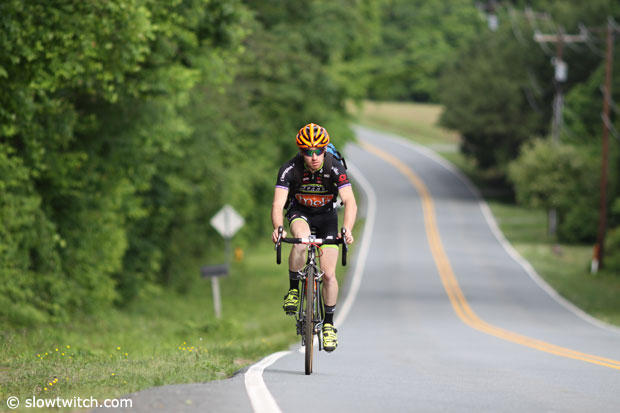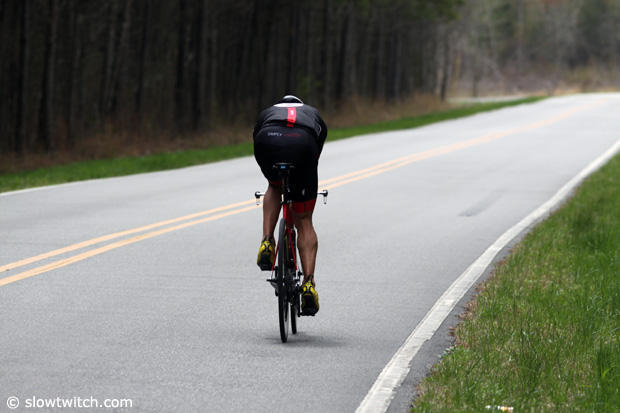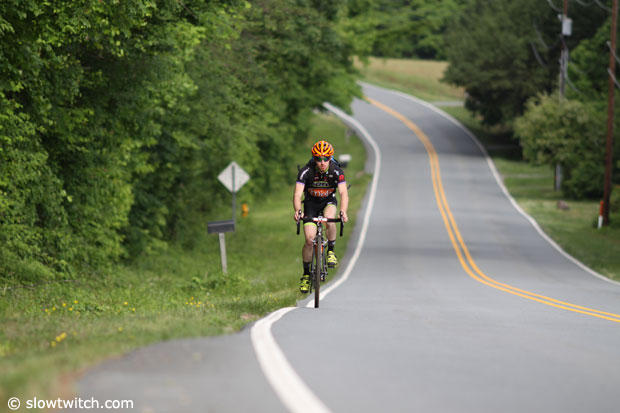Stayin’ Alive – Rural
When cars and cyclists collisde it's often, maybe usually, the driver's fault. But there are behaviors and habits that can prevent many of these tragedies.
This is not to suggest a shared culpability, rather that many drivers are unequipped to use weapons this powerful. We must make up the difference.
At best, all motorists get into their cars with baggage. Not briefcases and backpacks, but dreams, worries, mental to-do lists. Drivers are multi-taskers. Time is short, schedules are packed, it's simply not efficient to drive only. I'm not just talking about them, I'm talking about us. Once we stop pedaling and turn on our ignitions, we become them.
That's at best. At worst, we're sharing the roads with a significant number of motorists who are more than distracted. They're inept, hazardous, or menaces.
It's not a case of fault in an accident. It's a case of survival, and realizing how to steer clear of the worst among them, as well as the well-meaning, conscientious drivers who are simply distracted.
We can shake our fists in the air, or, we can prepare ourselves.

I'm going to write down the result of 40 years of trial-and-error on the roadways. Mind, I'm going to rise from my chair in a little while to go bike riding, and I might not survive the ride. A vehicle may foil all my defensive maneuvers and take me out. However, this regrettable possibility is just as prevalent when we're behind the wheels of our cars, is it not? How many head-on collisions between two vehicles occur on two-lane roads? Once you exit your property, the risk increases. So you become an agoraphobe or you venture forth, and do what you can to lessen the risk.
ROAD SELECTION
You drive to your swim workouts, do you not? I recommend you also consider driving to your cycling workouts, if you don't have safe roads proximate to you. Since you're only going to ride two or maybe three days a week, it's not that hard to strategically plan a bike route, and execute your ride on roads both scenic and safe.
What's my idea of a safe road? First, sparsity of traffic. I'm going to use Los Angeles as an example. You might think there is no such thing as a sparse stretch of pavement in this town, but L.A. has great rural riding.
The city most proximate to the Slowtwitch headquarters is Palmdale (often a start stage city for the Amgen Tour of California). Palmdale is a city of engineers. It's the home of Lockheed Skunk Works, proximate to Edwards Air Force Base, and, plenty of Palmdale's engineers commute to Pasadena's Jet Propulsion Laboratory. If I lived in Palmdale and commuted, I'd take my bike with me to work. On the way home I'd pull off the 210 freeway at Osborne Street and ride Little Tujunga Canyon. The next day I'd pull off the 14 freeway at San Canyon and ride that same fabulous, challenging road in the other direction.
The next day I'd pull off the I-14 at Acton and ride Aliso Canyon Road up to Mill Creek Summit on Angeles Forest Highway (often part of an ATOC stage).
All these are sparsely traveled roads, and cars have room to give you a wide berth. There are many low-density roads in SoCal. It amazes me that cyclists and triathletes who live in the L.A. Basin's South Bay (from Manhattan Beach to Santa Monica) ride north on heavily trafficked, stoplight-infested roads instead of simply driving their bikes to Malibu, where the good riding on challenging, scenic, spare and car-free roads commences.
BEHAVIOR ON COUNTRY ROADS
Yet, many of these horrible accidents actually do happen on sparsely traveled roads. So, even if you take my advice and find these roads, how can you remain safe?
Just as you never know who's going to swerve into you, creating a head-on accident while you're driving on roads like these, you never know when a motorist is going to cause a tragedy beyond your control to avert. It's a numbers game. Yet, there are a few tips I can share that increase my odds and that might increase yours.

1. You need your hearing. You need to know when a car is approaching. Therefore, I never ride with music streaming into my ears, and I recommend you don't either.
2. Music or no, wind direction plays an important part in what you can hear. If you're riding into a headwind, you can't hear what's coming up behind you. Therefore, when riding into a wind, you must recognize this, and be on extra alert.
3. We all ride as we are supposed to, by law, and that is as far to the right as is practicable. But that doesn't mean you straddle the fine line between asphalt and dirt. I ride 12" to 24" away from the edge of the roadbed, including when I hear a car approaching from the rear. I keep riding with my 12" to 24" margin. As I sense the car getting close—after he's calibrated for what he feels is his proper gap between his car and my bike—I gently steer toward the edge of the tarmac. By the time the car reaches me, I'm very nearly at the edge of the road. In other words, I've taken the margin the driver thinks he needs, and I've added an extra foot or foot-and-a-half margin he's not accounting for. The idea is to create this extra room late enough in the process so that the approaching car can't add this extra margin into his figuring.
4. I'm on high alert when a car is approaching from the other direction. Why? Because, if a car is approaching me from behind, and happens to pass me at the exact moment the car on the other side of the road passes by, now all three of us must squeeze through at the same time. For this reason, if a car is approaching from the other direction, well before that car approaches me I may look back and see what's coming up from behind. Otherwise, I employ the same tactic as described above, providing extra margin just as the oncoming vehicle passes me.
5. When there's one, there may be more. Keep in mind that when a car passes you from behind, that's not the end of it. Very likely there is a second, or even a train, of cars behind the first car. After I've made that extra margin for the car overtaking me, I don't immediately reestablish my normal 12" to 24" margin, because I have to keep that margin established for the cars that might come after the first overtaking vehicle.
6. Learn to look behind you without swerving. It's common to veer in the direction you look, that is, if you look over your shoulder to the left, it's common to then steer your bike marginally to the left. This is a bad habit. A dangerous habit. Best to train yourself how to look over your shoulder while keeping your bike in a straight line. This is not only a safer way to ride your bike in vehicular traffic, it's also a good way to keep from taking down cyclists who're riding behind you.
7. Trailers and trailer mirrors: I hate seeing utility trailers pulled by pick-ups coming up on me. Utility and horse trailers are frequently—in fact, usually—wider than the trucks pulling them. But the trucks' drivers don't recognize this, so, they allow you a margin gauged by the width of the truck, not the trailer. I'm on extra alert for these, and I try to use the tactics described above to grant myself the extra margin I need.
8. Let's talk about riding two and three abreast. You ladies and gents need to decide what's important to you: practicing your social life aboard your bikes; or riding safely. When you and I ride together, I can guarantee you that if we're riding two or more abreast, I'm going to be the one against the side of the roadbed. If you want to ride out there in traffic, be my guest. Just make sure I know your spouse's cell number, so that I can apprise him/her what hospital you're at. Conversely, if you ride directly in front of or behind me, I won't take it personally. We can catch up on social events at brunch after the ride is over.
I'm going to get blowback on this point. There is a term called "own the lane," and somehow this has to coexist with "ride as far to the right as practicable," the usual text for cyclists memorialized into the vehicle code.
Some own-the-laners are militant. Subversive. The right to the lane is what drives them, rather than safety.
But there's a safety element to owning the lane. When a car cannot pass you safely, and assuming one is not barreling down on you, yes, take the lane. Relinquish it (move to the right) when it's safe to pass. Use your own judgment when determining the instance when owning the lane is appropriate.
My strategy above of "owning" 2 feet of the lane, "bequeathing" it to the motorist a foot-and-a-half of it just prior to that car's arrival, is my own "mini" version of lane ownership.
I don't feel bad when a car crosses the double yellow to grant me my (often legally required) safety buffer. Yes, it could be interpreted that the motorist is forced into breaking one of two laws: the 3-foot law or the crossing-the-double-yellow law. But there is one interesting legal theory put forward by none other than the California Highway Patrol spokesman given to me specifically for the interpretation to this law. It's short. Read it carefully, see if you can find the legal theory, you'll find the link below the terminus of this article.
9. We're triathletes, so, we ride tri bikes. This means many of us have a special muscular burden we bear: in the backs of our necks. Just as a tired boxer let's his guard down, making him vulnerable to attack, so we're vulnerable to getting hit if we don't stay sufficiently diligent. Calibrate your bike position, and the distance of your ride, so that you're not spending an unsafe amount of time looking down instead of forward.
Above are 9 tips for safe rural riding, and I'm sure Slowtwitchers could add to this knowledge, and make this rule set an even 10.
[This article, in its original form, was published 5 years ago to the day. It has been amended for republication.]


